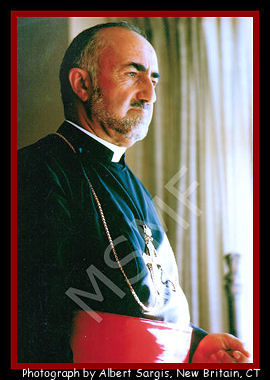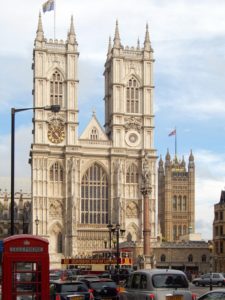H.H. Mar Eshai Shimun
(Click here for the Assyrian version)
 His Holiness Mar Eshai Shimun XXIII was the Catholicos Patriarch of the Church of the East, the Supreme Head of the Church and its Universal Pastor and the 119th Patriarch. The official name of the Church of the East is the Holy Apostolic and Catholic Church of the East. It was founded by the Apostles, St. Peter, St. Thomas, St. Thaddeus, St. Bartholomew and St. Mari of the Seventy.
His Holiness Mar Eshai Shimun XXIII was the Catholicos Patriarch of the Church of the East, the Supreme Head of the Church and its Universal Pastor and the 119th Patriarch. The official name of the Church of the East is the Holy Apostolic and Catholic Church of the East. It was founded by the Apostles, St. Peter, St. Thomas, St. Thaddeus, St. Bartholomew and St. Mari of the Seventy.
For clarity please note that the Church of the East is called different names by various historians. Some of the popular appellations are Assyrian Church, Nestorian Church, Chaldean Syrian Church, etc.
His Holiness was born on the 26th of February, 1908 in Qudchanis, the mountainous region located in southern Turkey. His Holiness was raised with great care while received the necessary theological and liturgical training by the late Archdeacon of the Patriarch, the Very Reverend Thoma of Ashita and by the Metropolitan of Rustaqa, His Grace, Mar Yosip Khnanishoo, who was also his uncle. At the age of twelve, due to geopolitical upheavals at the time, His Holiness was ordained as Patriarch in 1920, succeeding his uncle, Mar Poulus Shimun, XXII. In recognition of his keen intelligence and capability, it was deemed critical to further his education and training so the Patriarch was sent to St. Augustine’s College, Canterbury, England.
 After completing this phase of his preparatory schooling, he was accepted at Westcott House, Cambridge University, where he specialized in History and Statecraft. His formal schooling under the auspices of academia ended in 1927 when his nation and Church required his presence and leadership most. However, his informal education continued to evolve over the following two decades in which the harder school of adversity had magnified and deepened his wisdom and matured his personality. Experience is always a great teacher, and what a life of rich and varied experience His Holiness spent. Simply isolating two mere decades, from 1927 to 1947 in which he worked tirelessly fighting for his Assyrian people would for some be their failing, His Holiness Mar Eshai Shimun emerged as a profound and significant religious leader.
After completing this phase of his preparatory schooling, he was accepted at Westcott House, Cambridge University, where he specialized in History and Statecraft. His formal schooling under the auspices of academia ended in 1927 when his nation and Church required his presence and leadership most. However, his informal education continued to evolve over the following two decades in which the harder school of adversity had magnified and deepened his wisdom and matured his personality. Experience is always a great teacher, and what a life of rich and varied experience His Holiness spent. Simply isolating two mere decades, from 1927 to 1947 in which he worked tirelessly fighting for his Assyrian people would for some be their failing, His Holiness Mar Eshai Shimun emerged as a profound and significant religious leader.
Always on the move in Iraq, in Cyprus, in England, in Switzerland and in the United States and often in danger of life during the days of the disturbances in Iraq he met with foreign diplomats and heads of states. He persisted and created a world presence for the Assyrians by his representations to the League of Nations and later his appeals to the United Nations. All the while he was contacting world leaders and discussing with them the Assyrian Questions with his indefatigable energy and unfailing commitment. His Holiness’ dogged persistence, in fact his life, centered only around his duty to save his hapless Assyrians and his beloved Church of the East from utter destruction and disintegration.
Prior to Mar Eshai Shimun’s intervention, Assyrians living among their Islamic neighbor’s shared a tenuousness relationship that was firmly rooted in mistrust by both sides. Therefore, in 1948 His Holiness made a revolutionary announcement of a new policy for the Assyrian people and the Church of the East. Through direct contact to embassy representatives of the Middle Eastern countries in Washington and at the United Nations Headquarters, he broke down the walls of suspicion and misunderstanding. This new policy decreed Assyrians and members of the Church of the East all over the world to remain as loyal and faithful citizens of the countries in which they lived, something that had never been done before in our history. The result was electric. There were amiable responses from Syria, Lebanon, and Iran and cordial relations were established with these governments.
From his arrival in the United States in 1940, His Holiness had been active in establishing parishes, building churches, editing and translating literature from Aramaic into English for the use of the Church here in the United States and other countries. By doing so, he further promulgated the mission of the founding Apostles and sought to be an inclusive educator for this flock, so that all could learn the ancient liturgy in a consistent way. During this same period, the Patriarch had consecrated several bishops, ordained many priests and deacons and, established the first English speaking Assyrian parish in Seattle, Washington. All this work resulted in a substantive presence for the Church of the East throughout the United States. However, his work did not simply end here. Perhaps the most important of His Holiness activities had been the Apostolic pastoral visits which he had paid to the Churches in India, and the Middle East.
Most historic and significant were his trips to Iraq in 1970 and 1971, at the request of the Iraqi government. This unprecedented act sent waves of hope throughout the Assyrian community living in Iraq for it had been in 1933 that the Patriarch and his family had been exiled. For thirty-seven long years the Patriarch was forbidden a pastoral visit in which he was prohibited him from ministering to his considerable flock in Iraq. These trips had resulted in the strengthening of the spirit of the clergy and those faithful Assyrians. Furthermore, the building of schools, churches and the establishment of a Seminary in Tehran, Iran, occurred due to his direction and guardianship.
 His Holiness was a prolific scholar, an exemplary writer and a charismatic speaker. As early as 1926 at the age of 18, the Patriarch attended the Nicene Council Commemoration held at Westminster Abbey, London. The Church and State Conference held in Oxford and the Faith and Order Conference held in Edinburgh were both attended by His Holiness in 1937. The distinguished Athenaeum Club of London had bestowed upon His Holiness by conferring an honorary membership. He was also a member of the American Historical Society and other organizations as well as being a representative to the World Council of Churches and being a notable among the chronicles of Who’s Who. Numerous appeals and publications concerning the Assyrian Question, written by the Patriarch and presented to the British Government and various international bodies, highlight him as a writer of distinction. Many Syriac books have been translated into English by the His Holiness, Mar Eshai Shimun. Some of which are:
His Holiness was a prolific scholar, an exemplary writer and a charismatic speaker. As early as 1926 at the age of 18, the Patriarch attended the Nicene Council Commemoration held at Westminster Abbey, London. The Church and State Conference held in Oxford and the Faith and Order Conference held in Edinburgh were both attended by His Holiness in 1937. The distinguished Athenaeum Club of London had bestowed upon His Holiness by conferring an honorary membership. He was also a member of the American Historical Society and other organizations as well as being a representative to the World Council of Churches and being a notable among the chronicles of Who’s Who. Numerous appeals and publications concerning the Assyrian Question, written by the Patriarch and presented to the British Government and various international bodies, highlight him as a writer of distinction. Many Syriac books have been translated into English by the His Holiness, Mar Eshai Shimun. Some of which are:
- Portions of the Aramaic liturgy;
- The Book of Hymns and Praises;
- Synodical Rules of the Church of the East;
- The Book of Marganitha, a standard theological work of the Church of the East;
- The publication of the homilies of Mar Narsai, the great saint and scholar of the fifth century, in two volumes, numbering more than 1400 pages;
- along with seventy pages of introduction and critical apparatus in English by His Holiness as well as countless outstanding sermons on the historical doctrine of the Church of the East.
His Holiness was a world renowned subject matter expert in Ecclesiastical History and an authority on the History of Christianity in the Middle East and Far East. Mar Eshai Shimun was fluent and literate in both the Aramaic and modern Syriac languages. In 1940, Time Magazine wrote of his Holiness, “Cambridge-educated, Mar Shimun also speaks perfect English.” His scholarly discourses on Church History at international Ecclesiastical conferences at various Universities attracted world wide attention.
The succession of the patriarchs of the Mar Shimun family was a custom that became institutionalized for over 658 years, of which Mar Eshai Shimun, Catholicos Patriarch XXIII was the last. For Mar Eshai Shimun, his term as Patriarch was mired with tremendous hardship and the tenure of his indefatigable work on behalf of the Church of the East and the Assyrian nation that finally took its toll on him. Continuing the tradition of apostolic succession was impossible, for there were no d’Mar Shimun nephews to succeed him. His Holiness, ever mindful of his flock took the opportunity to take the growth and evolution of the glorious Church of the East to the next level had developed and proposed a plan for succession that was an electoral process, which had been accepted.
After 53 years of focused dedication, the patriarch retired from active responsibilities. In 1973 His Holiness announced his resignation from the Patriarchal responsibilities and married. Today, aside from his sisters and sister in law, nieces and nephews, he is survived by two children. It might not have been known broadly at the time, but the Patriarch had agreed to return to the Church to organize its affairs, at the request of the Bishops, including the Metropolitan Mar Yosip Khnanishu.
Sadly, his return was not to be realized. A clandestine plot was concocted to assassinate His Holiness, Mar Eshai Shimun XXIII, Catholicos Patriarch and carried out on November 6, 1975. An assassin gunned him down at the door of his home in San Jose, California. He was 67 years old.
Mar Eshai Shimun, XXIII, Catholicos Patriarch of the East was an innovative leader of the Church and the Assyrian people, well schooled in not only the ecclesiastical aspects of his vocation, but erudite and learned in ways of geopolitical issues. Always attuned to the needs of his flock and the nation, he mindfully navigated the tenuous geopolitical landscape with uncompromising ethics, integrity and superior leadership which were the hallmarks of his character. His ingrained spirituality and political sophistication set him apart as a true leader of distinction. Never has an Assyrian leader demonstrated such sophistication and agility in managing both the secular and temporal affairs bespoke of his truly magnificent stewardship of the Assyrian people and the Church of the East.

AUDIO AND VIDEO
blank
Mar Eshai Shimun Video
Chicago – 1943
Chicago – 1946
Iran – 1963
Consecrations, 1960’s
Iraq 1970
Chicago, Illinois – 1970 Jubilee Celebration Dinner Speech
Memorial Services Graveside Memorial Service, Turlock, California, November 2000
Mar Eshai Shimun Audio
- Chicago 1943 Christmas reading on NBC Radio done by HHMES at Mar Sargis church Chicago
- HH Mar Eshai Shimun offering Holy Communion or Razeh Qadisha, New Britain, Connecticut 1962
- Mar Eshai Shimun Speech at Mar Zaia Church, Iraq, 1970
- Mar Dinkha radio address delivered after HH Mar Eshai Shimun’s assassination, Modesto, California 1975
- HH Mar Eshai Shimun, Memorial Dirge or Madrasha – by Rev. Barkho Oshana 1985
Mar Benyamin Shimun Video
- (CURRENTLY UNAVAILABLE) The Assassination of Mar Benyamin Shimun XX, Catholicos Patriarch excerpted from The History of the Assyrians in World War I + II or Atouria Tre Plasheh Tee Wee Lai Yah by Yacoub Malik Ismail.
- Tribute to Mar Benyamin Shimun XXI, created by Robert Khnanisho
Mar Benyamin Shimun Audio
-
Mar Benyamin Audio Clips
- Mar Benyamin Dirge sung by Eglanteen Warda, in the Syriac language. Lryrics by Sophia Kajarian, and music by Ninos Patros
- Mar Benyamin, Memorial Dirge by Rev. Barkho Oshana
- Shlama L’Rookhokh Mar Benyamin Hymn written by Deacon Yousif Nooro and sung by Mrs. Jina Nanno Kena
- La Pashmeeton Mookhebby Hymn written by Deacon Yousif Nooro and sung by Mrs. Jina Nanno Kena
- Mar Benyamin Kahana Qadeesha Hymn written by Deacon Yousif Nooro and sung by Mrs. Jina Nanno Kena
- Interview with Edward Nadirsha hosted by Emanuel Isho in memory of the assassination of Mar Benyamin (2014)
